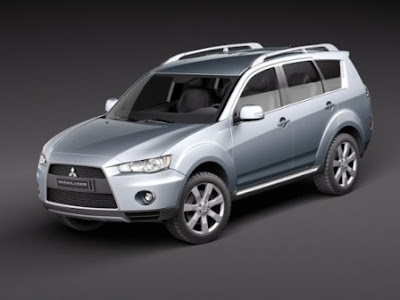
The Mitsubishi Outlander GT trim level was new last year to the Mitsubishi Outlander lineup and returns for the 2011 model year carrying all the same equipment, such as the all-wheel-drive system from the Lancer Evolution, a potent V6 engine and tight handling dynamics. Other than the price, the 2011 Mitsubishi Outlander GT is unchanged, and that's OK. The Outlander stays nicely planted around turns, yet the suspension still offers adequate absorption abilities for the rough road conditions so very common around Detroit after a long winter.
The Rockford Fosgate sound system, which is part of the optional Touring package installed on our tester, sounds great, too. The big wheels and decent ground clearance helped as well.
The premier model in the 2011 Mitsubishi Outlander lineup receives a "GT" rear badge along with a "S-AWC" rear decal, the latter alphanumeric designation signifying this crossover's exceptional traction enhancing Super All-Wheel Control system that was originally developed by Mitsubishi engineers for the company's legendary Lancer Evolution high-performance sports sedan.
The 2011 Outlander GT comes equipped with a wide array of standard amenities and convenience features.
The good: The 2011 Mitsubishi Outlander GT's S-AWC system does a fantastic job of keeping the crossover's handling in line, even in wet conditions. The Evolution X's claim to fame is its S-AWC all-wheel-drive system. To review the Mitsubishi Outlander GT S-AWC, we need to keep the Evo in mind.
The S-AWC system means the 2011 Mitsubishi Outlander GT gets Mitsubishi's Active Center Differential (ACD), which sends nearly 100 percent of available torque to the front axle under normal conditions, but can divert as much as half of the available torque from the 3.0-liter engine to the rear axle for a 50/50 split. It also gets Super Active Yaw Control (S-AYC), a torque-vectoring system that uses an active differential to send up to 70 percent of torque available on an axle to either the left or right wheel to enhance handling.
The 2011 Mitsubishi Outlander GT S-AWC system has three modes. Torque is still automatically apportioned between the front and rear axles. We put the Outlander's S-AYC to the test on the same mountain roads on which we tested the Acura MDX SH-AWD's torque-vectoring system; however, the roads were slicked with rain this time around, adding an extra level of danger for the GT's S-AWC system to deal with.
The Outlander's instrument cluster featuresan S-AWC indicator that provides information about the operation of the ACD and S-AYC systems. The way the Mitsubishi Outlander GT front end pulls itself back in line is predictable and, if you're not looking for it, nearly transparent. Pushing the Outlander too hard in wet conditions would overwhelm even the S-AWC system. Impressive as the Outlander is, an Evo X it is not.
The world's most uncomfortable third-row seat
Besides the Outlander being generally larger overall, one of the key differences between the Outlander and the Outlander Sport is the availability of a third-row seat that boosts our Mitsubishi Outlander GT model into the seven-seater class.
No comments:
Post a Comment